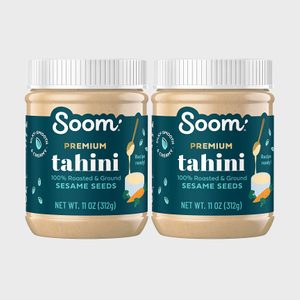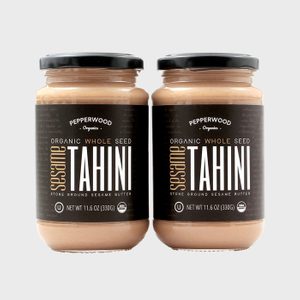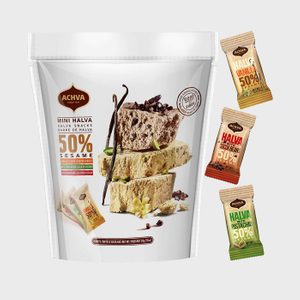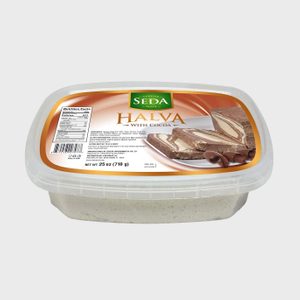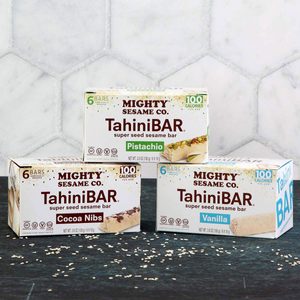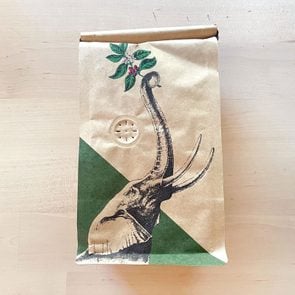What Is Tahini, Exactly?
Updated: Mar. 26, 2023

You've seen it in recipes, and you've seen it on menus, but have you ever stopped to think, What is tahini? Find out here.
If you’ve ever dunked a carrot in hummus, scooped baba ghanoush onto a chip or drizzled that creamy, non-yogurt dressing on your falafel or gyro, you’ve eaten tahini. All these popular Middle Eastern dishes feature this condiment, but what is tahini, exactly?
For many Americans, tahini falls into the food-mystery category, along with miso and umami. So we’re pulling back the curtain—just as we explained where pine nuts come from and answered the question are peanuts nuts?—to give you the food facts you need to know about tahini.
Get Reader’s Digest’s Read Up newsletter for more food news, humor, cleaning, travel, tech and fun facts all week long.
So, what is tahini?
In short, tahini is like peanut butter but made with sesame seeds instead of peanuts, and it has a slightly runnier texture. According to cookbook author Adeena Sussman, writing for the Jewish Book Council, tahini has been made and eaten for centuries in the region of the Middle East that includes Israel, Syria, Lebanon, Jordan and the Palestinian territories.
In fact, after people in China, Israelis enjoy the most sesame seeds per capita in the world. This isn’t surprising when you consider that tahini is a key ingredient in hummus and the tahini-based sweet called halvah, not to mention that it can be used to make dressings, dips, cookies, breads and sauces, all to delicious effect.
What is tahini made of?
There’s an easy answer to this food quiz question! As mentioned above, sesame seeds are the most important ingredient in tahini. These hulled seeds are ground and sometimes mixed with oil and salt until smooth and creamy. As with any natural nut butter, you’ll typically see some separation between the sesame paste and the oil when you open a new jar of tahini—but a quick, thorough stir will reincorporate the ingredients till they’re a pourable consistency.
And to the question of what is tahini sauce: It will typically include some added liquid, as many recipes feature lemon juice and water, or even an additional flavor booster like garlic.
What does tahini taste like?
The flavor of tahini is earthy and nutty. It’s also quite mild and versatile, which is why tahini lends itself so well to both sweet treats and savory sauces—unlike other imported ingredients like wasabi or sriracha, which tend to stay in the savory lane. The tahini that’s made by most brands available in the United States (you should be able to find it in almost any grocery store) is typically the plain or original flavor, sans any added flavorings or ingredients (but vanilla and barbecue are options too!).
What’s the best way to use tahini?
There are numerous ways to use tahini, and they’re all delicious. On the savory side, it’s commonly found in hummus and tahini-based sauces and dips, including eggplant-based baba ghanoush. But tahini is also tasty in sweet recipes. The most popular tahini-based sweet, halvah, is a slightly crumbly treat sold in bars and sometimes covered in chocolate. (Joyva, the largest U.S. retailer of halvah, also sells tahini by the tub in supermarkets.) Cookie recipes that include tahini are also popular.
What’s a good substitute for tahini?
In the same way that margarine can be used to replace butter, cashew butter is the best substitute for tahini, as it comes closest in flavor, color and consistency. Perhaps surprisingly, sesame paste is not a good substitute. Made from unhulled sesame seeds instead of hulled, this Asian ingredient has a much richer flavor, darker color and thicker texture than its Middle Eastern counterpart.
Are hummus and tahini the same thing?
No, hummus and tahini are not the same. But tahini is one of the most important ingredients in hummus, behind chickpeas. Without tahini, hummus would be a chunky, oily mess, as tahini provides the ultra-creamy base that helps the chickpea dip achieve its mouthwateringly smooth and thick consistency. So, what is tahini? It’s the unsung hero of every bowl of hummus.
How should you store tahini?
Just like other natural nut and seed butters, tahini can be stored in the pantry before opening. Once it’s been opened, it should be kept in the refrigerator to maximize its shelf life. (It’s not technically necessary to refrigerate it, but it will last longer.) Tahini may undergo some separation if it’s not used for a while; if that happens, simply stir it back to smoothness. And also like nut butters, tahini will last for up to a year before it starts to go bad. Next, find out what is burrata – and what makes this pasta so creamy.
Is tahini healthy?
Since tahini is made almost exclusively of ground sesame seeds, it carries with it all the good-for-you health benefits of sesame seeds. Considering their small size, sesame seeds—and tahini, by association—are packed with healthy fat, fiber and protein. Tahini is also rich in calcium, potassium and magnesium, nutrients that contribute to healthy blood pressure, steady energy levels and strong bones, among other perks. Additional studies have found that the plant compounds in sesame seeds may help lower cholesterol levels and even temper the severity of menopause symptoms.
All that said, sesame is a major allergen. In fact, in 2023, the Food and Drug Administration named sesame the ninth major allergen, joining milk, eggs, fish, shellfish, tree nuts, peanuts, wheat and soybeans on the list of foods required to be labeled as an allergen on all packaged foods. So if you or someone you know is allergic to sesame, be aware that tahini is a no-no.
Now that you know what tahini is, learn where vanilla flavoring comes from and what corn syrup is.
Sources:
- Jewish Book Council: “Tahini: A Brief History”
- U.S. Food & Drug Administration: “Allergic to Sesame? Food Labels Now Must List Sesame as an Allergen”




















